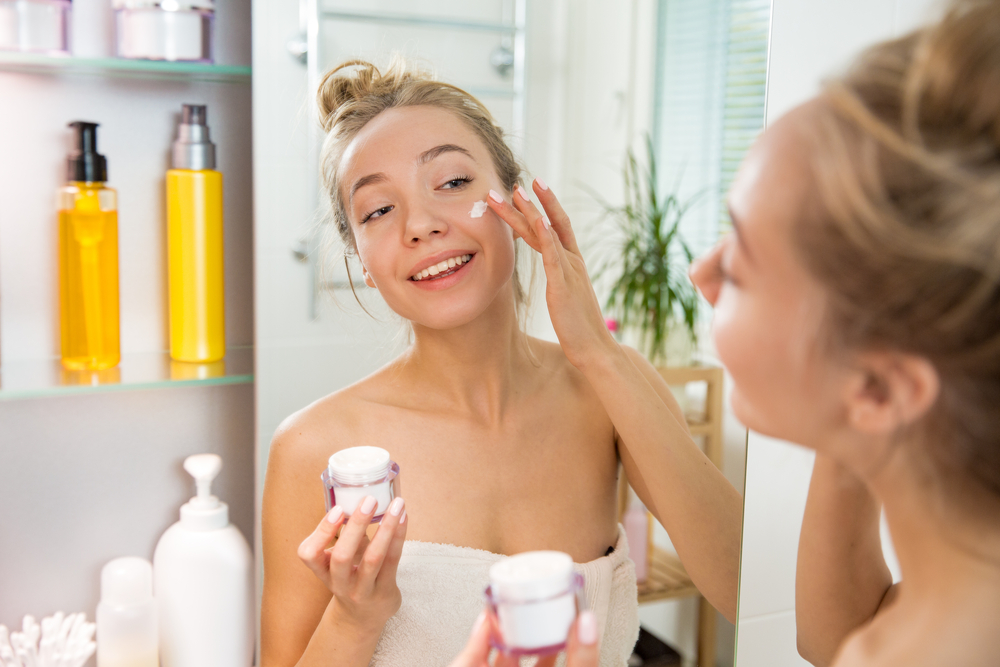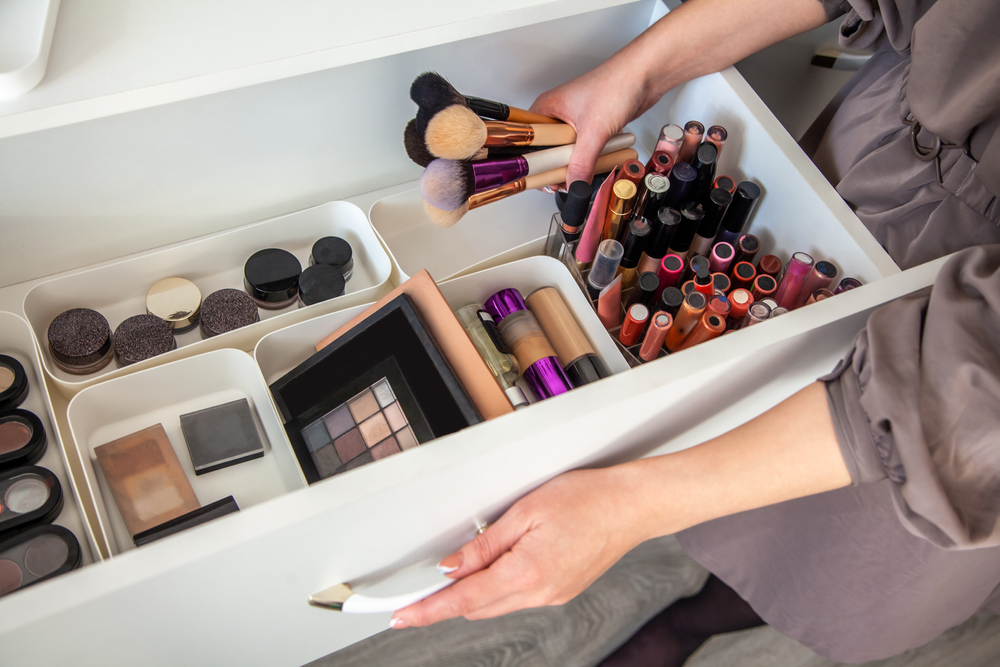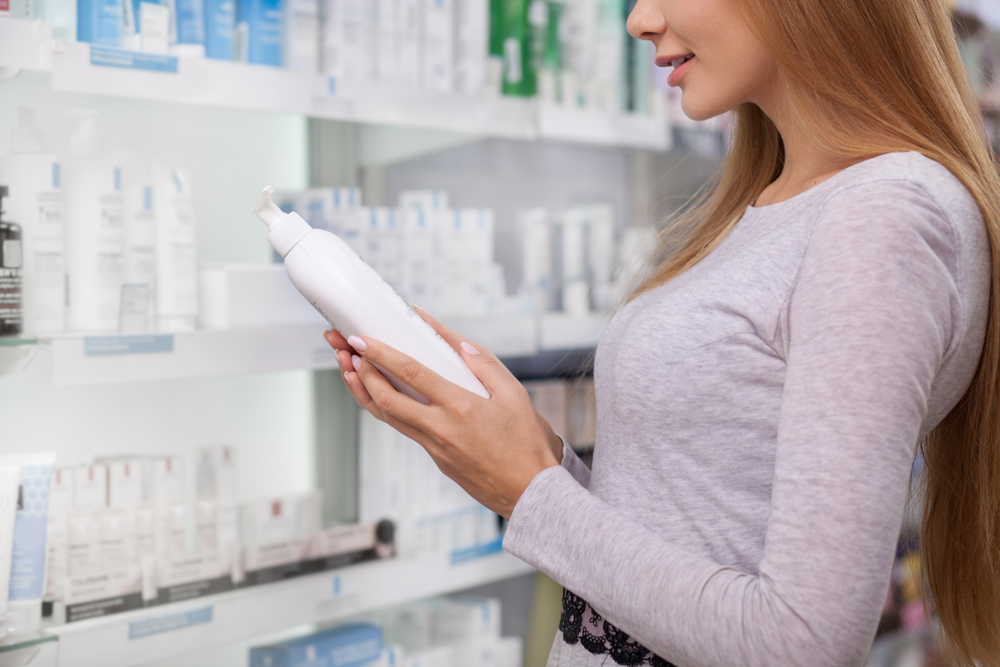
Source: Aleksandra Suzi/Shutterstock.com
Do you know what you’re putting on your skin? I mean, really know? When you apply beauty products like lotions and moisturizers (the list goes on) to your skin, you want it to absorb or stay in place. That’s the point. But are you aware of what kinds of ingredients your skin is absorbing? There are countless chemicals out there, all designed to preserve and enhance. But sometimes, these toxic ingredients can have more severe side effects. They can make us break out in a rash, at a minimum, but they can even disrupt our hormones on an unnoticeable level.
From that teeth whitening pen you store in your purse to your shampoos, what you put on your skin and your body should be safe and offer you a clean beauty routine. Familiarize yourself with the “Dirty Dozen” and read the ingredients closely. By understanding what goes into products and how they’re made, you can make a more informed choice and create a clean beauty routine.
Pay Attention to Ingredients (and Don’t Be Greenwashed)
When it comes to beauty products, you need to pay attention to the ingredients. Don’t just glance at the packaging for some kind of green-certified label (which may or may not be real). Actually, do your research by turning it over and reading what makes it clean. You do the same with nutrition labels before eating foods, so do the same for what you apply to your skin.
While many stick with the easy method of avoiding products with ingredient names you can’t pronounce, it’s more complicated than that. Instead, you need to familiarize yourself with scientific names of natural ingredients, too, because they can be just as long! From teeth whitening kits to nail polish, you want to ensure that what goes on your body is safe and free of harmful chemicals.
To familiarize yourself more, learn about what’s called the “Dirty Dozen” and the “Made Without List.”
The ‘Dirty Dozen’
The “Dirty Dozen” is a list of 12 harmful, toxic ingredients commonly found in beauty products. Memorize them and scan a product’s label of ingredients before you add it to your cart.
- BHA and BHT
- Coal tar dyes (p-phenylenediamine and colors listed as “CI” followed by a five-digit number)
- DEA-related ingredients
- Dibutyl phthalate
- Formaldehyde-releasing preservatives
- Parabens
- Parfum (aka fragrance)
- PEG compounds
- Petrolatum
- Siloxanes
- Sodium Laureth Sulfate
- Triclosan
The ‘Made Without List’
The “Made Without List” goes a step further and lists 29 ingredients. While it’s hard to remember every single one, Ulta has put together this list of ingredients to provide transparency and help consumers choose beauty products wisely and make an informed decision. The “Made Without List” also ensures that formulas are safe and free of components that are derived from animals and ingredients that are tested on animals.
Throw Out Toxic and Expired Beauty Products

Source: Kostikova Natalia/Shutterstock.com
Once you understand the “Dirty Dozen” and know how to spot harmful chemicals in your beauty products, it’s time to toss out the toxic junk. Go through your bathroom and any areas where you store beauty products, examining the ingredients closer. Also, simply check the expiration date, tossing anything old. Even consider tossing out stuff you rarely use. If you haven’t touched it in a year, free your drawer of one more piece of clutter.
While this is hard for some beauty queens, you need to practice some tough love and say goodbye to cosmetics and beauty products that only take up room on your vanity. Edit thoughtfully down to your must-have essentials and you will feel lighter. This cleanse will even make you a bit more selective on your next purchase.
Choose Environmentally-Friendly Products
Now that you have a clean start, so to speak, try to reach for clean beauty products. However, clean doesn’t always mean clean on your skin. Clean can also mean good for the earth. Here are a few resources that can help you seek out more environmentally-friendly cosmetic products.
Environmental Working Group
The EWG’s Skin Deep Database offers resources on 70,000 products. Search for the product and see what turns up. Wrapped up neatly, this database provides an ingredient-by-ingredient breakdown, as well as an overall score and a detailed list of any possible concerns and sensitivities.
Leaping Bunny
If you are vegan or simply care about our animal friends, this one’s for you. Leaping Bunny is an organization that offers a stamped seal of approval to brands that pass their cruelty-free guidelines. They even offer a convenient app you can download and use while shopping. Or, simply reach for beauty products with the cute bunny logo.
Familiarize Yourself with Clean Beauty Brands
As you search for new non-toxic beauty products for your clean beauty routine, try to familiarize yourself with common clean beauty brands. You can do your own research browsing the EWG database or simply google a brand to see what comes up. Unlike a decade or so ago, today, we are offered countless clean beauty brands. And you don’t have to dig deep either. Even big-box stores like Target offer a variety of natural brands, affordable enough for the common consumer.
Experiment with Your New Clean Beauty Products

Source: MAD_Production/shutterstock.com
Test and experiment with your new clean beauty products. Determine what you like and don’t like (or more specifically, what your skin and hair like). Once you get acquainted with these cleaner ingredients, you can understand how to apply them in a way that helps your complexion and skin appear younger and more aesthetically pleasing to the eye.
Remember: Natural Isn’t Necessarily Better
There are many natural ingredients that are not necessarily better or even clean. Essential oils, for example, are a completely natural plant compound used in many pharmaceutical-grade natural remedies. However, they are not regulated by the FDA and become toxic when used incorrectly. It could cause mild skin irritation and even a more severe allergic reaction.
The same goes for other natural ingredients like talc and even clays, which can be contaminated with toxic heavy metals. Sometimes, believe it or not, the synthetic version might be less harmful to you and the environment.
Leave a Reply